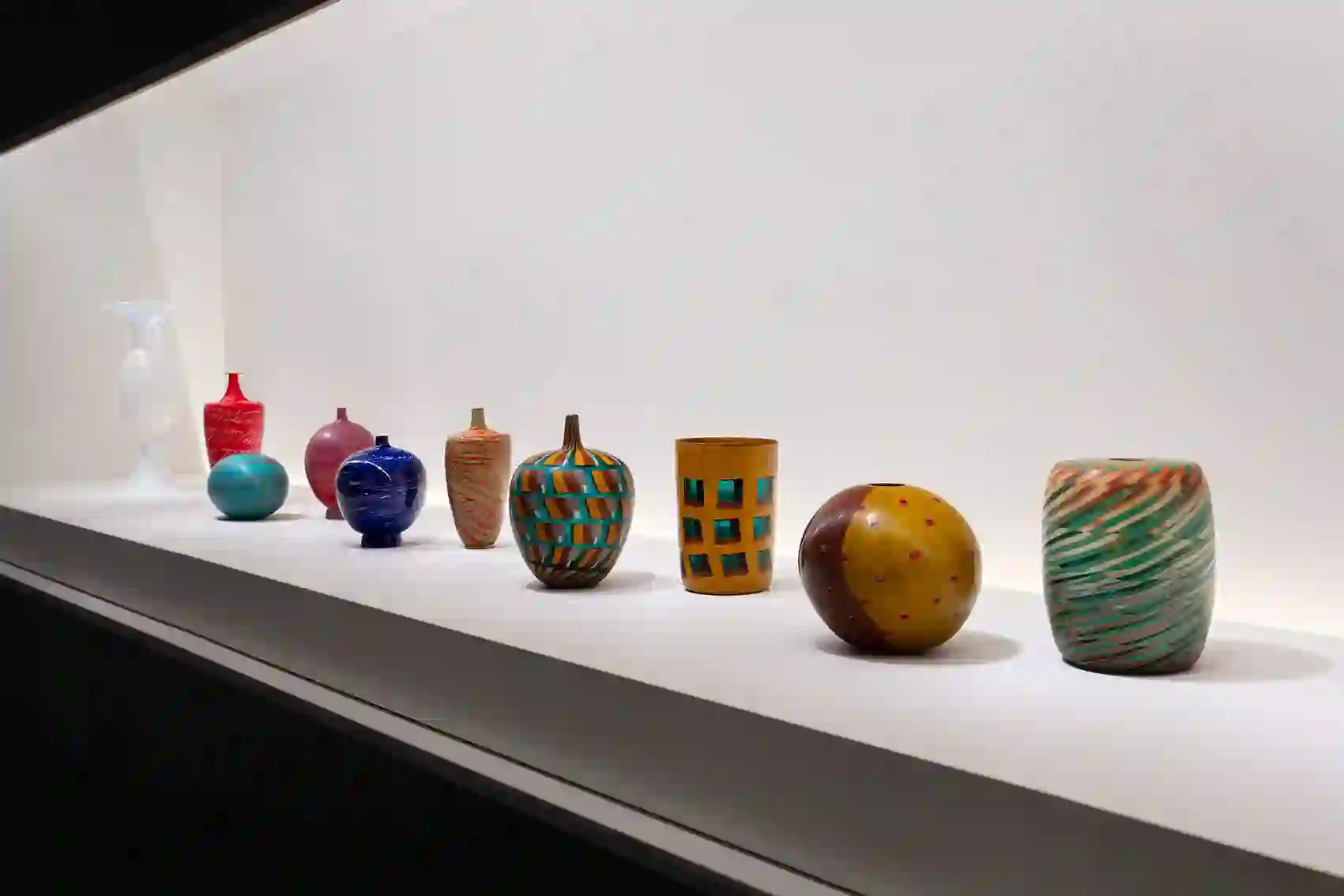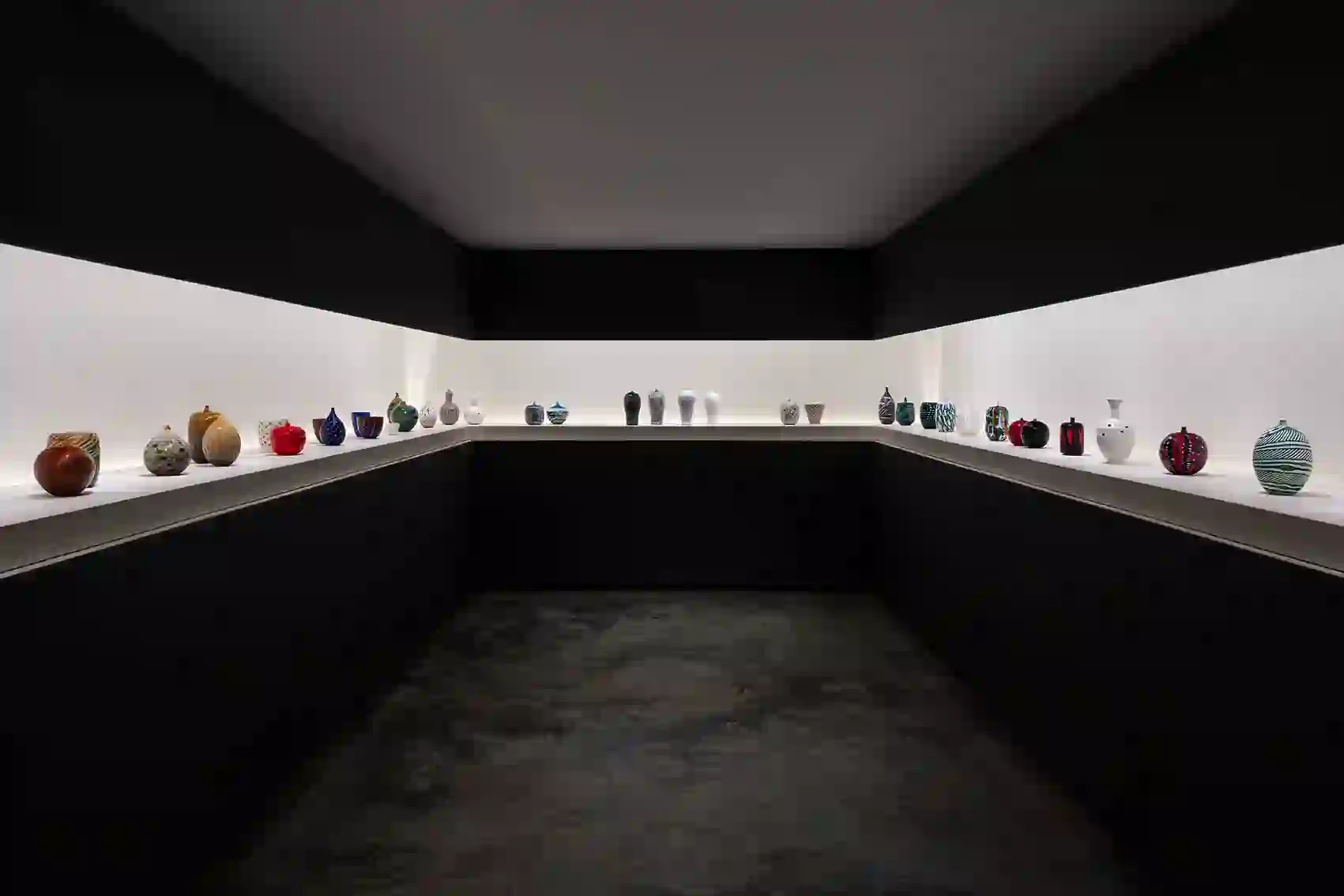Yoichi Ohira: Japan in Murano showcases the work of Yoichi Ohira (1946–2022), a Japanese artist who became a leading figure in designing Venetian glassworks on the island of Murano, Italy. The exhibition unfolds through clusters of works that illustrate aesthetic resonances, chromatic contrasts, and formal affinities, creating dialogues across different periods of the artist’s career.
The first works Ohira made in Murano showcase a continuity with the great Venetian tradition: mastery of techniques such as filigrana a reticello and incalmo is combined with the artist’s sensibility, and it is evident in the use of balanced proportions, clear surfaces, and carefully calibrated color juxtapositions. The series of decanters Venezia e l’Oriente (Venice and the Orient) is representative of this period. Drawing from the centuries-old relationship between the ancient Republic of Venice and the Eastern world (Constantinople, the Ottoman Empire, the Far East), Ohira created a series of vases that reinterpret wonders worthy of Marco Polo’s tales through a measured, postmodern exoticism.
Already in this first phase of his career, Ohira’s deep respect for the intelligence and skills of Murano’s master glassmakers is evident. Each object is the result of close dialogue with the island’s maestri, and the production process is accompanied by preparatory drawings that serve as maps to transform ideas into blown glass. A vivid vocabulary of lines, colors, metaphors, and adjectives communicates Ohira’s perception of the material through words and images, revealing the beauty of volumes and transparencies in their conceptual stages.

From the mid-1990s onward, Ohira entered a phase of great creative freedom. He abandoned the constraints of serial production and focused on unique pieces. Here, colors—milky or vibrant hues; the interplay of opacity and transparency; unusual combinations that recall hardstones, Japanese lacquer, wood, leather, or minerals weathered by time— take center stage. Ohira’s vocabulary of forms expanded, profiles curved, and surfaces grew richer with intricate patterns. Ancient techniques such as murrine and battuto were reinterpreted in contemporary ways, sometimes pushing the material to behave “against its nature” in order to achieve surprising effects.
Always grounded in close observation of nature, Ohira’s mature work celebrates the chromatic richness and vitality of Murano glass: calligraphic lines and vivid colors, transparencies that amplify the artistic potential of light, and a density of matter and hue that evokes the Venetian lagoon’s shifting impressions, as if painted onto glass. Among the most remarkable works of this golden period are masterpieces such as the Acqua alta di Venezia (Venice at High Tide) vases, in which Ohira’s use of powders in glass creates the impression of ancient pavements, juxtaposed to battuto blue glass evoking the restless waters of high tide. During these intense years of artistic production, the subject of the vase becomes a pretext to explore a highly figurative imagination, nurtured by the study of architecture, by the natural forms of fruits and vegetables, by celestial phenomena like the phases of the Moon, by cityscapes and geological formations.

In the final years of his career, Ohira embraced reduction. He abandoned nearly all color and focused on the relationships between crystal and light, and the balance of volumes and voids. The traditional form of the vase, though still respected, became openly sculptural, transforming thick yet transparent matter into monumental, luminous forms. This phase reveals the artist as a master of subtraction: once naturalistic and figurative references were slowly stripped away, Ohira’s work became an expression of silence, a volume in which negative space and light are integral to form. It is a return to origins—not in a technical sense, but a spiritual one. Ohira had fallen in love with glass as a young man after reading a novella by Hiroyuki Itsuki in which the author described glassmaking as “music without sound.” In these final works, the material returns to silence, and becomes an instrument of visual meditation.
About Yoichi Ohira
Yoichi Ohira (Tokyo, 1946–2022) was a Japanese artist of international renown. After graduating in 1969 from the Kuwasawa Design School in Tokyo, Ohira began working as an apprentice glassmaker at the Kagami Crystal Company, where he gained first-hand experience with the optical and formal potential of glass. In 1973, he moved to Venice to study sculpture at the Accademia di Belle Arti, graduating with top honors in 1978 with a thesis entitled The Aesthetics of Glass. During his years in Venice, Ohira developed a relationship with Egidio Costantini, founder of the Fucina degli Angeli glassworks and a master of the art of translating two-dimensional works into glass sculpture. Through a collaboration with Peggy Guggenheim, Costantini entered into dialogue with artists such as Pablo Picasso, Jean Cocteau, Max Ernst, Alexander Calder, Lucio Fontana, and Georges Braque. Ohira’s encounter with Costantini was decisive in shaping his sensibility. Glass would no longer be a mere decorative medium, but rather a fully autonomous artistic language. In 1987, Ohira was appointed Artistic Director of the de Majo glassworks in Murano, where he created collections that connected Eastern forms with Venetian techniques, winning that year the prestigious Premio Selezione at the Premio Murano glass art competition. In 1992, he embarked on an independent career, collaborating with master glassblowers Livio Serena and Andrea Zilio and master glass carver Giacomo Barbini to produce unique works of extraordinary refinement. His first solo exhibition of Venetian glass was held in 1997 at Caffè Florian in Piazza San Marco. Over the course of his career, he exhibited internationally alongside masters such as Carlo Scarpa, Lino Tagliapietra, Dale Chihuly, Laura de Santillana, and other leading figures of the contemporary glass scene. Ohira was also the first artist in Murano to sign each glass work with its exact date of production and the names of both the master glassblower and the master glass cutter, a decision that underscores his respect for their knowledge, skill, and pivotal role in bringing his masterpieces to life. He has participated in the most important international exhibitions and his works are greatly appreciated by private collectors as well as many public museums. Yoichi Ohira’s work is, today, part of the permanent collections of museums such as the Victoria and Albert Museum of London, the Musée des Arts Décoratifs in Paris, the Metropolitan Museum of Art in New York, the Koganezaki Glass Museum in Shizoka, Japan, and many others.
